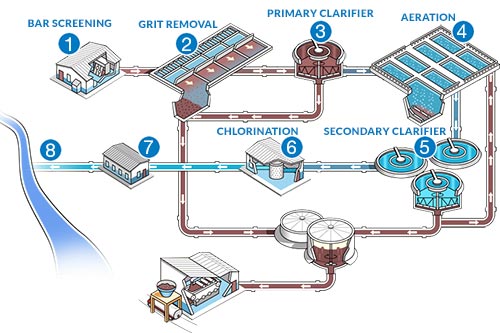Key Advantages of Upgrading Your Current Wastewater Treatment System
Key Advantages of Upgrading Your Current Wastewater Treatment System
Blog Article
Comprehending Wastewater Therapy Processes and Their Environmental Effect
The intricacies of wastewater treatment processes play a pivotal function in mitigating ecological challenges linked with water pollution. Each stage, from initial to sophisticated therapies, is developed to deal with certain impurities, inevitably safeguarding both public health and water environments.
Review of Wastewater Treatment
Just how is wastewater changed right into a safe source for the atmosphere? Wastewater treatment is an important process made to get rid of contaminants from made use of water, consequently protecting public health and securing environments. This process begins with the collection of wastewater from residential, commercial, and commercial resources, which is after that directed to therapy facilities.
At these centers, different physical, chemical, and organic techniques are used to treat the wastewater. Preliminary screening gets rid of big debris, adhered to by sedimentation to different heavier solids. Subsequently, organic treatments, such as turned on sludge procedures, make use of bacteria to damage down raw material. These approaches not only reduce pollutant levels yet likewise facilitate the recuperation of important nutrients.
The dealt with effluent can be securely discharged into natural water bodies or reused for irrigation and industrial purposes, promoting source preservation. Additionally, the therapy process creates biosolids, which can be repurposed as fertilizers or dirt amendments, further boosting sustainability.
Phases of Treatment Processes
The wastewater treatment procedure generally includes three main phases: preliminary, main, and second therapy. Each stage offers an unique role in minimizing the pollutant lots and making certain the effluent satisfies ecological standards prior to discharge.

The primary therapy stage concentrates on the physical splitting up of suspended solids from the wastewater. Through sedimentation, larger particles clear up at the base of sedimentation tanks, creating sludge, while lighter materials, such as oils and greases, float to the surface area and are skimmed off. This process substantially lowers the organic and not natural load in the wastewater.
Secondary treatment is an organic process intended at additional decreasing the focus of natural issue. This stage is important for accomplishing the needed biochemical oxygen need (FIGURE) decrease, ultimately leading to cleaner effluent ready for discharge or more treatment.

Advanced Therapy Technologies
Complying with the additional therapy processes, progressed treatment technologies play a crucial function in further improving the top quality of treated wastewater. These innovations are developed to get rid of residual contaminants that are not effectively gotten rid of throughout key and second therapies, making certain the effluent satisfies rigorous regulatory standards.
Among the commonly used innovative treatment approaches are membrane filtration, reverse osmosis, and advanced oxidation processes. Membrane filtering, consisting of microfiltration and ultrafiltration, works in dividing fine particles, microorganisms, and colloids from the water (Wastewater). Reverse osmosis utilizes semi-permeable membranes to eliminate dissolved solids, resulting in top quality water appropriate for various applications
Advanced oxidation processes (AOPs) utilize solid oxidants to weaken organic contaminants, consisting of drugs and individual care products that are resistant to traditional treatment. These methods enhance the biodegradability of complex compounds, promoting their removal.
An additional significant technology is using biological nutrient removal processes, which particularly target nitrogen and phosphorus, avoiding eutrophication in receiving water bodies. In general, innovative treatment technologies are necessary for achieving greater degrees of filtration, promoting water reuse, and securing public wellness while dealing with the obstacles connected with wastewater monitoring.
Environmental Advantages of Therapy
Many environmental advantages occur from efficient wastewater treatment procedures that add to ecosystem wellness and sustainability. Mostly, these processes dramatically lower the release of continue reading this hazardous toxins into all-natural water bodies, which helps maintain marine ecosystems. By eliminating contaminants such as hefty metals, nutrients, and virus, treated wastewater alleviates the danger of waterborne illness and promotes biodiversity in marine environments.
In addition, wastewater therapy facilities typically utilize innovative modern technologies that make it possible for water recycling and reuse. This practice not just conserves fresh water sources yet additionally minimizes the demand on natural water materials. Improved nutrient removal from wastewater can additionally avoid eutrophication, a process that leads to algal flowers and succeeding oxygen depletion in aquatic systems.
Furthermore, efficient therapy procedures can decrease greenhouse gas exhausts, specifically methane and nitrous oxide, which are often released throughout without treatment wastewater decay. By catching and making use of biogas from anaerobic digesters, centers can convert waste into renewable power, therefore adding to a reduction in fossil fuel dependency.
Obstacles and Future Trends
While the environmental advantages of wastewater treatment are clear, several difficulties linger that impede optimal end results in this field. One major issue is maturing facilities, which often results in inadequacies and raised operational expenses - Wastewater. Numerous therapy plants were created years ago, and their capacities do not straighten with modern needs, that include more stringent regulatory criteria and greater volumes of wastewater because of urbanization

Looking ahead, there is an expanding focus on resource healing and round economic climate principles within wastewater therapy. Developments such as anaerobic food digestion, which can generate biogas, and advanced filtration technologies are gaining traction. These techniques not only improve treatment performance but also advertise sustainability.
Eventually, attending to these difficulties requires collaboration amongst stakeholders, financial investment in innovation, and a dedication to continuous Go Here research. By accepting these fads, the wastewater treatment field can progress to satisfy the demands of a transforming environment and culture.
Conclusion
In verdict, wastewater treatment processes play a crucial function in boosting environmental quality and public health and wellness. The multi-stage treatment framework, combined with sophisticated modern technologies, properly mitigates contamination and promotes sustainable water management. By dealing with recurring contaminants and get redirected here decreasing nutrient overflow, these processes add to the conservation of marine ecosystems and the decrease of greenhouse gas exhausts. Continued developments and adaptations in treatment techniques will certainly be necessary for getting over arising obstacles and making sure the sustainability of natural deposits (Wastewater).
Report this page